Beef BBQ Ribs Recipe excels through slow-cooking techniques and wood smoke exposure, creating a complex flavor profile that combines savory, smoky, and sweet notes. The key components are a well-crafted barbecue sauce for moisture and taste, and the selection of meaty, marbled beef cuts like ribeye or short rib. Cooking methods vary between dry and wet rubs for different textures and flavors. A traditional approach involves preheating the oven to 300°F (150°C), cooking for 2-3 hours, brushing on sauce, and caramelizing for 30-60 minutes. Glazing techniques with brown sugar, mustard, and liquid smoke further enhance flavor. Strategic pairings like coleslaw, corn, or grilled vegetables complement the rich barbecue sauce.
Discover the secrets behind crafting the perfect Beef BBQ Ribs Recipe with a savory, smoky flavor enhanced by rich barbecue sauce. This comprehensive guide explores everything from understanding the allure of smoky tastes and the role of sauce in beef ribs to choosing the ideal cut of meat and mastering dry or wet rubs. Learn effective cooking methods, glazing techniques, and pairing suggestions to elevate your BBQ rib experience.
- Understanding Savory Smoky Flavor
- The Role of Barbecue Sauce in Beef BBQ Ribs
- Choosing the Right Cut of Meat for Ribs
- Dry Rub vs Wet Rub: Which to Use?
- Cooking Method and Temperature Control
- Glazing Techniques for a Rich Sauce
- Pairing Suggestions for Your BBQ Ribs
Understanding Savory Smoky Flavor
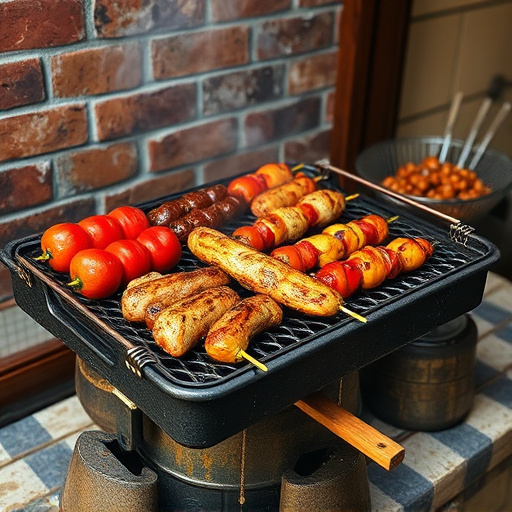
The savory, smoky flavor is a hallmark of many beloved dishes, particularly in barbecue cuisine, like a hearty Beef BBQ Ribs Recipe. This distinctive taste comes from various factors, primarily the result of slow-cooking techniques and wood-smoke exposure. The process of smoking meat involves low and indirect heat, allowing the natural juices to slowly bake into the food, infusing it with a rich, complex flavor.
In the case of beef BBQ ribs, this method not only tenderizes the meat but also adds a subtle smokiness that complements the sweet and tangy barbecue sauce. The combination creates an explosion of flavors on the palate—a perfect balance between savory, smoky, and slightly sweet notes, making it a beloved choice for barbecue enthusiasts.
The Role of Barbecue Sauce in Beef BBQ Ribs
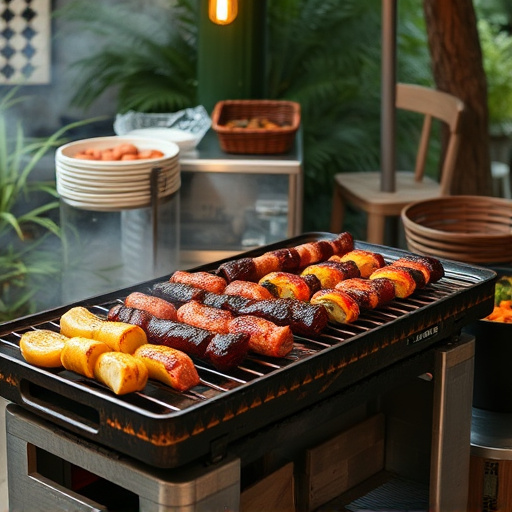
The barbecue sauce is a pivotal element in elevating the taste profile of Beef BBQ Ribs, infusing them with a savory, smoky flavor that defines this classic dish. In a typical Beef BBQ Ribs Recipe, the sauce serves multiple functions: it tenderizes the ribs during cooking, adding moisture and preventing them from becoming dry; it adds complexity to the overall flavor, balancing the richness of the beef with tangy, slightly sweet notes characteristic of good barbecue sauce; and finally, it provides a delightful glaze that caramelizes on the surface when baked or grilled, creating a mouthwatering crunchy texture.
Choosing the right sauce can significantly impact the final dish. A good Beef BBQ Ribs Recipe will use a blend of tomato-based sauces, vinegar, brown sugar, spices, and smoke for depth. This combination not only enhances the smoky flavor but also contributes to the ribs’ distinctive charred aroma, making them irresistible to any meat lover.
Choosing the Right Cut of Meat for Ribs

When crafting a mouthwatering beef BBQ ribs recipe, selecting the perfect cut of meat is paramount. Look for meaty, marbled ribs with a good layer of fat—this ensures moisture and flavor throughout the cooking process. The most common cuts include ribeye, short rib, or a blend specifically designed for BBQ ribs. These cuts have abundant marbling, which renders as delicious bacon-like flavors during slow-cooking, resulting in tender, succulent ribs.
For authentic Beef BBQ Ribs, opt for bones with some meat attached (known as “full ribs”) rather than separated rib chunks. The bones act as natural conduits, conducting heat and enhancing the smoky flavor. Consider the thickness of your ribs; thicker cuts take longer to cook but tend to stay moister. This classic preparation allows the savory smoky flavor to penetrate deep into the meat, creating a rich barbecue sauce experience with every bite.
Dry Rub vs Wet Rub: Which to Use?
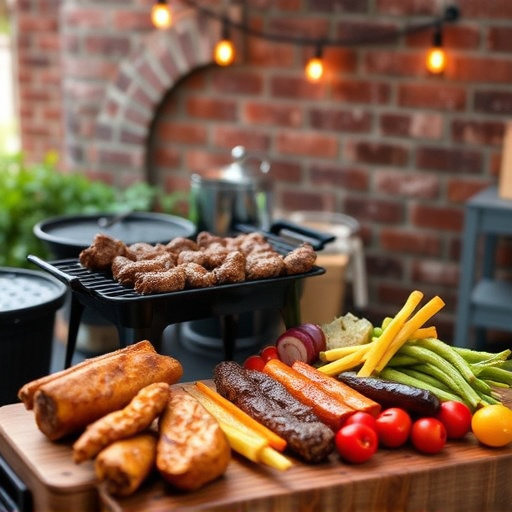
When preparing beef BBQ ribs, one key decision is choosing between a dry rub or wet rub. Dry rubs are simply blends of spices that coat the meat, relying on flavor infusion during cooking. This method offers precise control over spice levels and allows individual tastes to shine through. It’s ideal for showcasing high-quality meat and enhancing its natural flavors without overpowering them.
Wet rubs, on the other hand, include a base of liquid such as vinegar, soy sauce, or fruit juices, in addition to spices. These rubs add moisture to the cooking process, resulting in tenderer ribs with a rich, glistening crust. Wet rubs are perfect for those who prefer a more intense, complex flavor profile and don’t mind a touch of extra sugar or acidity balancing the savory, smoky taste. For a classic beef BBQ ribs recipe, consider a dry rub to highlight the meat’s integrity while still delivering a robust, memorable flavor experience.
Cooking Method and Temperature Control
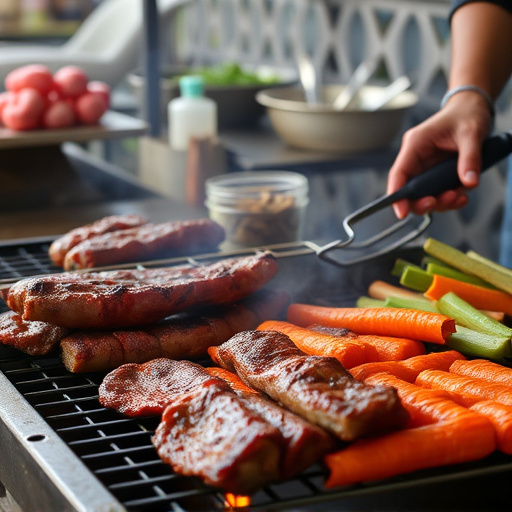
When preparing Beef BBQ Ribs, the cooking method and temperature control are paramount to achieving that perfect savory, smoky flavor with a rich barbecue sauce. Start by preheating your oven to 300°F (150°C). This low and slow approach allows for even cooking and helps preserve the ribs’ moisture. After seasoning the ribs with your favorite BBQ rub, place them bone-side down in a baking dish. Cover the dish loosely with aluminum foil, creating an environment that traps moisture and heat.
Cooking time can vary depending on the thickness of the ribs, but plan for approximately 2-3 hours. Regularly check the internal temperature using a meat thermometer; the goal is to reach 195°F (90°C). Once the ribs hit this mark, carefully remove them from the oven and brush on your favorite barbecue sauce. Return them to the oven, uncovered, for an additional 30 minutes to an hour to let the sauce caramelize and deepen its flavor. This final step ensures that the ribs are both tender and glaze-coated, making them ready to be devoured in your Beef BBQ Ribs Recipe.
Glazing Techniques for a Rich Sauce

To elevate your Beef BBQ Ribs Recipe, consider using glazing techniques for a rich sauce that enhances every bite. Glazing isn’t just about adding shine; it deepens the flavor profile and creates a mouthwatering crust on the ribs. A simple method is to brush on a thick layer of barbecue sauce during the last 10 minutes of cooking. This not only adds a smoky, sweet taste but also helps caramelize the sauce for a richer texture.
For an even more immersive experience, consider making a glaze by combining ingredients like brown sugar, mustard, and liquid smoke. This mixture can be brushed onto the ribs or cooked in a slow cooker for a few hours to create a deep, savory flavor with a subtly smoky aroma. These techniques transform your traditional Beef BBQ Ribs Recipe into a truly exceptional culinary delight.
Pairing Suggestions for Your BBQ Ribs
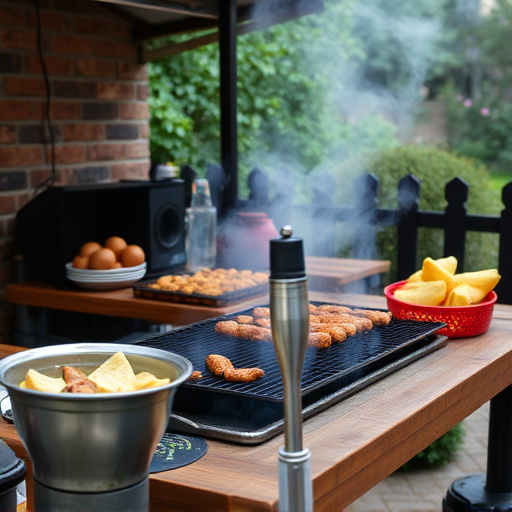
When it comes to beef BBQ ribs recipes, pairing is key to enhancing that savory, smoky flavor. For a classic combination, pair your ribs with coleslaw – the crunch and tanginess cut through the richness of the barbecue sauce. Corn on the cob is another perfect match, as the sweetness of the corn complements the smoky ribs.
If you’re looking for something a little more adventurous, consider grilled vegetables like zucchini or bell peppers. Their charred edges mimic the rib’s smoky taste, and they offer a refreshing texture contrast. Pairing your Beef BBQ Ribs with beer is also a popular choice; the carbonation cuts through the sauce’s richness, while the malted flavors enhance the barbecue notes.
